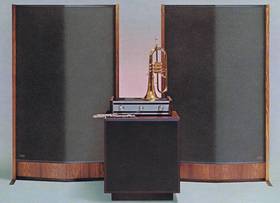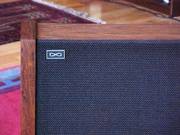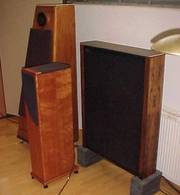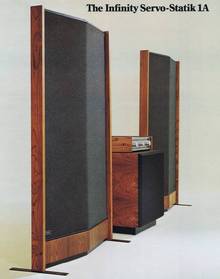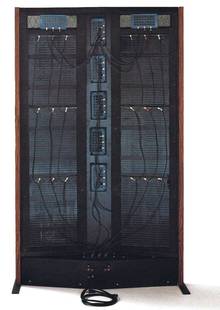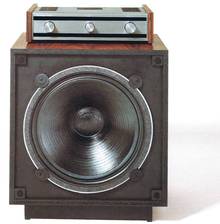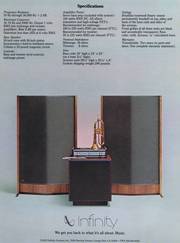Die Nachfolgerin der Servo Static 1 war die Infinity SS 1A
War die Lautsprecherkombination Infinity SS1 aus 1969 bereits der absolute Traum der damaligen Hifi-Welt, dann war die SS 1A aus 1974/75 der Übertraum. Doch bleiben wir im Vorgriff mal etwas näher bei der Wahrheit und der Realität.
Die ältere SS1 war 1969 in dieser Konzeption mit elektrostatischen Hochtönern und elektrostatischen Mitteltönern und einem großen dynamischen 48cm Mono- Baßchassis völlig neu. Auch die nicht veränderbare (oder verhandelbare) aktive Ansteuerung aller 3 Frequenzbereiche mit (zwei) sehr teuren Stereo-Endstufen war ein Muß und nicht jedem potentiellen Fan zu vermitteln.
.
Und einfach mal aufmachen durfte man die ältere SS1 anfänglich auch nicht. (wegen der 5 Jahre Garantie) Die SS1"A" hatte dann nur noch 2 Jahre Garantie. Das mit den 5 Jahren war wohl etwas vermessen. Weiterhin mußte man als Kaufwilliger mit den mehr oder weniger scharfen Bildern aus den Hifi-Magazinen dieser Erde leben.
Bei eigener Anschauung (des Innenlebens der SS1) wäre man völlig ernüchtert mit seiner Rechnung (Kaufquittung) in der Hand erst mal drei Stunden durch den Wald getapst, um sich abzureagieren. Wir sprechen von anfänglichen DM 14.000.- - und das ohne die beiden zusätzlichen Edel-Verstärker.
Jedes dieser insgesamt ca. 200 SS1 Systeme war zwar (zu seiner Zeit) genial gut und bestimmt waren die einzelnen Komponenten auch alle vom Feinsten und vor allem - in der kleinen Serie - gleich gut. Doch die "amerikanische" Verarbeitung ähnelte auch am Ende des Produktzyklus immer noch einem Labormuster. Daran hatte sich in den drei bis fünf Jahren nichts geändert.
Übrigens - schaun Sie sich mal die legendäre AR 3 und AR 3a (von Acoustical Research) in offenem Zustand an. Dann wird Ihnen auch fast übel. Das alles ist mit einem gestylten JBL Innenleben nicht zu vergleichen. Außen war die Palisanderverkleidung (brasilianisches Rosewood) schon sehr edel und auch sehr sauber verarbeitet - aber innen ........ na ja ........
.
Die SS1"A" bestand aus fast den gleichen Komponenten
Herrmann Hoffmann erzählte mir, daß in den ersten 20 gelieferten SS1 eine bestimmte Type Baßchassis eingebaut wurde und dann kamen andere - zwar gleich große Chassis - von anderen Herstellern und dann wieder andere. Die einen hatten die resistente aber steife Leinensicke, die anderen eine weichere Gummisicke und wieder andere eine dieser zerbröselnden Schaumstoffsicken. In der SS1"A" war dann wieder ein anderes Baßchassis drinnen. Dafür waren es die gleichen elektrostatischen Hoch- und Mitteltöner, davon aber eine größere Anzahl.
Bei den elektrostatischen Mitteltönern ist mir damals bereits aufgefallen, daß die schalldurchlässigen Schlitze der Plastik-Halbschalen Verkleidungen im Vergleich zu der gesamten Mittelton-Fläche recht klein waren. Das bremste natürlich die Luft bzw. die Schallwellen - trotz der großen Fläche - und damit die Effizienz stark ab. Die Servo Statik war absolut ineffizient, wenn man einen DC300A (2 x 190 Watt an 8 Ohm und 2 x 300 Watt an 4 Ohm) nur für den Mittenbereich brauchte. Auch der Hochtonbereich sollte mit einer guten 2 x 50 Watt Endstufe betrieben werden.
Das alles im Vorgriff auf die Werbesprüche und Lobeshymnen des SS1"A" Prospektes in englisher Sprache.
.
Doch jetzt zu dem "SS1A" Prospekt mit den tollen Sprüchen . . .
natürlich auf Englisch :
.
The Infinity Servo-Statik 1A System
Without distortion, without exaggeration, without question, without an equal.
The goal is easy enough to define: simply the totally accurate re-creation of the musical performance itself. Simply!
In fact, no other loudspeaker system in the world can approach that ideal as does this one - the Servo-Statik 1A.
This is the one instrument capable of sound reproduction more distortion-free, throughout a wider dynamic range and greater frequency spectrum than any other speaker ever made. Because the Servo-Statik 1A is the most technically advanced speaker system in the world - it is also the most musical.
Its not for everyone (also nur für echte Millionäre ?)
.
- Not everyone is prepared at first to accept the transparent honesty of the Servo-Statik 1A - for it exposes every flaw in a bad recording, as clearly as it reveals every nuance of beauty in a good one.
- Not everyone can cater to its capability - and we hope never to hear that a Servo-Statik 1A has been imprisoned in a tiny room, or shackled to just ordinary components.
- And not everyone can afford it - few indeed are the music-lovers in a position to show that they really do appreciate the Servo-Statik 1A more than three thousand dollars' worth.
- If you are one of those few, read on. And listen with open ears. And maybe we can do business. If you are not one of those few, read on anyway. And some day ... some day ...
.
A box with a box on top + two tall screens = one sophisticated system
The Servo-Statik 1A doesn't even look like any other speaker system. It consists of a bass cube with its own servo amplifier, and two electrostatic screens about five feet high.
The bass cube incorporates an 18" woofer with a 35 pound magnetic circuit; a feedback sensor; and an electronic crossover unit with high-voltage FET's. Its DC servo amplifier supplies 150 watts of RMS power.
Each screen contains electrostatic midrange modules and tweeter modules with their own built-in power supplies.
The working of each of these ingredients in life-breathing music reproduction is detailed below. Frankly, the words convey no inkling of the experience of hearing - for the first time, through the Servo-Statik 1A - the sweet thunder of the full orchestra at full gallop, or a virtuoso soloist's sensitive, personal shadings ... from a recording!
The servo bass system, the woofer, and the feedback principle
What happens when the Servo-Statik 1A meets the challenge of a crescendo tympani-roll?
The bass speaker must have equal sensitivity to each element of performance: the clear attack sound of the mallets - articulated not as a rumble, but as separate-but-related sounds - the rising volume of fundamental tones of the tymp; and its overtones.
And the electronics of the system must clearly separate these tymp tones from unison notes being doubled by basses, bassoons, or bass trombone pedal tones.
(Oh, the responsibility of being an Infinity woofer!)
One reason our 18-inch woofer is so wonderfully accurate is the way we treat the cone. First we stiffen it into hypersensitive rigidity. Then we damp it heavily to absorb any sound impulse inclined to linger too long. First in, first out - and no leftovers get mixed with what's cooking this instant.
.
As the voice coil drives the cone to its excursions of as much as a half-inch, the built-in servo system's sensing element records a signal exactly proportional to those movements. The signal gives a precise measure of any deviation between the impulses, or electronic energy coming out of the power amplifier and the motions, or acoustic energy coming out of the speaker. Fed back into the input of the amplifier, this signal corrects any deviations in the speaker-instantaneously.
The result is accurate bass such as you could never hear without the application of the feedback principle. Except maybe at the live performance. If your seats were good enough.
The woofer is housed in a furniture cabinet built as if to support a thousand-pound piece of statuary. With two-by-fours, we solidly brace and cross-brace every wall of the cube to every other wall. Then, to soak up any stray sound-wave surviving inside, we pack an inordinate amount of sound-absorbing material into every remaining space in the cabinet. No part of the sound that comes out of this box is the sound of the box itself.
And the range, free of spurious resonances, is tremendous - clear down to the full sonority of a cathedral organ's largest pipe: an almost inaudible 15 Hz.
The electronic crossover network
The bass amplifier contains the three-way electronic crossover. The unit uses all high-voltage Field Effect Transistors (FET's) rather than operational amplifiers or discrete bipolars. And its FET gain-cell circuitry passes audio signals along without adding the slightest sound of its own. That's music you hear - not electronics.
The crossover routes tones below 70Hz to the woofer; those above 2000Hz to the tweeters; and tones between those limits to the midrange electrostatics. Crossover rates are 6dB per octave throughout, for perfect linearity and phase response.
The electrostatic screens (bei uns "Paneele")
The electrostatic transducer is an exceptional sound-reproducer for three main reasons:
.
- The moving system is of extremely low mass. The diaphragm of a midrange electrostat is extremely thin-about .0005". It therefore gives excellent transient response because the diaphragm can be accelerated very rapidly, while the resistance of the air load in front of the diaphragm damps out any overshoot. In the tweeters, the even lower mass of the diaphragm (.00025" thinness) can give flat frequency response beyond 30.000Hz - well beyond human audibility.
- The electrostatic driving force is distributed uniformly over the entire diaphragm. As a result, "cone breakup" is virtually eliminated. (This distortion factor in conventional speakers is caused by the cone's being driven only at its center.)
- Electrostatics produce constant energy output over their entire frequency range.
.
Beyond having these generic advantages, Infinity's electrostatics are vastly different from others:
They have exceptional high power capacity. Therefore they can handle the output of almost any amplifier. The grids on each side of the diaphragm are highly conductive rather than highly resistive. Therefore they give constant power output and exceptional articulation.
After ceaseless trial and error and discovery and refinement, our unique arrangement and phasing of the tweeters has eliminated the dispersion problem. And accomplished much more.
By arraying a narrow strip of tweeters vertically; by supplementing them with horizontally arrayed tweeters along the top of each screen; by adding the correct amount of reflected sound in the room (the screens radiate half their energy to the rear)...
We have created, through the Servo-Statik 1A, a totally accurate three-dimensional musical image from two recorded channels. When the room comes alive with the sound of the concert hall itself, you can literally place every instrument or section - left, left-center, center, right-center, and right. And in depth as well: foreground, middle and back.
Power supply and matching transformers
(es geht um die Hochspannungstransformatoren in den beiden Paneelen)
These components may be left out of most discussions of electrostatic speakers, but their effect on overall sound quality is too important to ignore.
All ordinary electrostatic power supplies are one-half-wave rectifier bridges. They cause the diaphragm to ripple just a little, producing a slightly less-than-uniform flow of DC charge. For us, slightly is too much. So we designed in a costly full-wave rectifier bridge. And the Servo-Statik 1A inched closer to the goal of absolute freedom from distortion.
The matching transformers for the midrange and tweeter sections are truly state-of-art. We built and rejected 13 successively better midrange transformers before the fourteenth satisfied our stubborn insistence on the ideal. The silicon steel is processed for uniform magnetic properties. New close-coupled winding techniques are employed. And truly "colorless" transformers are a reality.
.
Notes on integrating the Servo-Statik 1A into a stereo system
Only the finest associated components can match the fidelity of this sophisticated speaker system. Any audio specialist well-informed enough to handle the Servo-Statik 1A is qualified to help you select them.
Or drop us a note, and we'll send you our recommendations.
A state-of-the-art loudspeaker system should have separate amplifiers driving each section. For the midrange, RMS power of 100 to 250 watts per channel is recommended. The tweeter amplifier may be more modest in power output - 35 to 125 watts RMS per channel. Do not skimp on amplification; the Servo-Statik 1A will expose the limitations of an inadequate amplifier just as surely as it will expose the shortcomings of an inferior recording.
But get it all together, and there really is nothing like the Servo-Statik 1A music experience.
The Servo-Statik 1A
Distortion-free sound reproduction; the widest dynamic range ever achieved; the greatest frequency response in any speaker system yet manufactured - they all have their price. In the Servo-Statik 1A it comes to well over $ 3.000.
The listener with enough funds, enough space, and enough sensitivity to buy and appreciate this staggering achievement is to be envied. And will be.
How it came to be
The founding fathers of Infinity Systems created the progenitor of the Servo-Statik 1A to prove a point, rather than to sell.
Our point was this: "All existing speakers are guilty of distortion - some of them by design. We aerospace physicist music-freaks can apply some things we know about lasers and the like to building a speaker system with a whole new reason for being: accuracy. It may be too terribly expensive to sell. But it will advance the state of the art. And it will sound great in our homes."
The result was the original Servo-Statik 1, and as it happened, we sold as many as we could make. Thanks to a cult of Servo-Statik 1 worshippers, all pulling the coats and twisting the arms of music-loving friends to "come hear what / discovered" And thanks to almost embarrassing praise in the audio press.
Stereophile Magazine said, ".. the word that best describes the sound of the Infinity Servo-Statik 1 on large-scale choral or orchestral music is 'stupendous! It is a long time since anything we have heard has literally given us goose bumps, but the Servo-Statik 1 did it time and time again, until we found ourselves relistening to recordings we haven't pulled from the shelves for years, just to enjoy the sound of them"
And CBS Laboratories, upon measuring that original Servo-Statik 1 and finding its anechoic response to be 25Hz to 20,000Hz ± 3.5dB (a measurement never equalled by any other speaker until today) commented, "The complex orchestral and choral passages of Bernstein's demanding recording of the Mahler Third Symphony came through with a fullness, clarity, and sense of breadth and depth that were exhilarating. As one of those present commented, 'I doubt that Bernstein himself heard it any more clearly during the performance'".
We were more than gratified. But less than satisfied. Now, after six more years of discoveries in homogeneity of sound, evenness of radiation, and the pioneering use of new materials and electronics:
Infinity proudly presents the Servo-Statik 1A.
Specifications
Frequency Response: 10Hz through 30.000Hz ± 2dB.
Electronic Crossover: At 70Hz and 2000Hz. Output 7 volts RMS into midrange and tweeter amplifiers. Rate 6dB per octave. Distortion less than .01% at 6 volts RMS.
Bass Speaker: 18-inch cone with 16-inch piston. Incorporates a built-in feedback sensor. Utilizes a 35-pound magnetic circuit.
Controls: Bass and tweeter level controls; midrange preset.
Amplifier Power: Servo bass amp (included with system):
150 watts RMS DC. All silicon transistors and high-voltage FET's.
Recommended for midrange: 100 to 250 watts RMS per channel (FTC).
Recommended for tweeter: 35 to 125 watts RMS per channel (FTC).
Nominal Impedance: Midrange: 16 ohms. Tweeter: 8 ohms.
Size: Bass cube 19" high x 22" x 22" (on a base 2 1/2" high).
Screens each 59 1/2" high x 35 1/2" x 8"
System shipping weight 290 pounds.
Styling: Brazilian rosewood (heavy veneer permanently bonded) on top, sides, and back of the bass cube and sides of the screens.
Front grilles of all three units are black and acoustically transparent. Bass
cube: cloth. Screens: W' reticulated foam.
Warranty:
Transferable. Two years on parts and labor. (See complete warranty statement).

